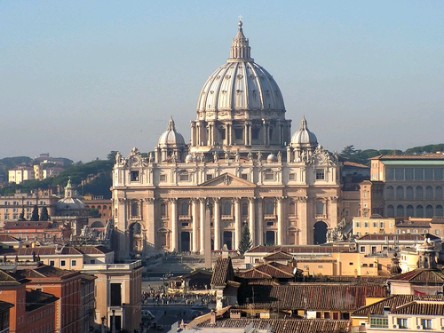
Vatican City is the official center of the Roman Catholic Church and the home of the Pope (currently Benedict XVI), as well as one of the most famous countries in the world, despite being part of a city. It includes four Basilicas: the most famous one, the Papal Basilica of St. Peter; the Basilica of St. John Lateran; the Basilica of St. Mary Major; and the Basilica of St. Paul Outside the Walls. There are three parts of the Vatican of special interest to historians: the Vatican Museum, which showcases the art owned by the Vatican; the Vatican Library, which was created to release the historical documents owned by the Vatican to any scholars who wish to see them; and the Vatican Secret Archives, created to document the activities of the Popes.
The history of the Vatican goes back before Christianity. The name originally referred to a marshy area on the right bank of the Tiber River between the Milvio Bridge and the modern Sixtus Bridge. Before the Roman Empire, it was known as Ager Vaticanus. It extended north to the mouth of the Cremera and south to the Janiculum. During the Empire, the name Vaticanum was used to refer to the area that is now Vatican City. According to tradition, St. Peter was martyred by Nero in a small circus (according to the Roman sense, meaning circular area) built by Caligula for charioteers. Peter was buried nearby, and this led to the religious growth of the area near the tomb: many Christian pilgrims wished to see the tomb of the man to whom Jesus entrusted the Church.
Christianity was legalized in 313 by Emperor Constantine with the Edict of Milan, and a great church dedicated to St. Peter was started in 324. This original version of St. Peter's Basilica had a nave, stairs, a four-sided portico, four aisles, a transept, and an apse, with the tomb of Peter at the center. During the building of the Basilica, the circus fell into disrepair, due to neglect and the use of its materials to build the Basilica. Many years later, Pope Leo IV built the first walls of the "civitas", also known as the "Leonina". During the Middle Ages, the Popes lived in the Lateran Palace, although some buildings were built near the Basilica. When the papal court moved to Avignon in 1309, Rome and the Basilica were abandoned for a century.
The city only recovered fifty years after the Popes returned, in 1377. Although plans were made to rebuild the Basilica, the fall of Constantinople put an end to them. It was not until 1477 when Pope Sixtus IV built a great chapel that was decorated by the greatest painters of the time, that the Vatican was restarted. Pope Julius II rebuilt St. Peter's Basilica and built the Belvedere Courtyard, which connected the Palace of Belvedere the north, built by Innocent VIII, and the medieval buildings to the south. He summoned Raphael Santi and Michelangelo Buonarroti and asked Raphael to fresco the papal apartments and Michelangelo to fresco the Sistine Chapel. Michelangelo was also asked to plan and build the new Basilica, which was then covered with a vaulted dome by Giacomo Della Porta. Two later additions were made: Carlo Maderno added two bays and Gian Lorenzo Bernini designed the square with two hemicycles of four rows of columns.
The Vatican became independent as an absolute monarchy on February 11, 1929, after the signing of the Lateran Pacts. They were ratified on June 7, and became the first sovereign state headed by a spiritual leader. The central government is made up of the Pope and the Departments of the Roman Curia, which exist to aid the Pope in his duties. The Departments of the Roman Curia are divided into judicial, legislative, and executive branches. The judicial branch consists of a Judge, Tribunal, Appeals Court, and Supreme Court. The legislative branch is the Pope and the Pontifical Commission for Vatican City State. The executive branch is headed by the Cardinal President of the Pontifical Commission for Vatican City State, who also has the title of President of the Governorate. Under him is the Secretary General, the Deputy Secretary General, and the Administration and Central Offices of the Governorate. The General Councillor and the State Council can aid the Pontifical Commission and President. The Pontifical Military Corps were disbanded by Pope Paul VI on September 14, 1970. Vatican City is now guarded by the Swiss Guard and the Gendarme Corps of Vatican City act as a police force.